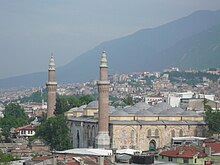Great Mosque of Bursa
The Great Mosque ( Turkish Ulu Cami ) is a Friday mosque in the Turkish city of Bursa . The early Ottoman style church was commissioned by Sultan Bayezid I and built between 1396 and 1399. In addition to other mosques in Bursa, the Great Mosque is an example of early Ottoman monumental buildings of the "inverted T" or "Bursa type".
history
The Ulu Cami is the largest mosque in the city and an example of early Ottoman architecture that still incorporated numerous elements of Seljuk architecture. Architect Ali Neccar built the building between 1396 and 1399 on behalf of Sultan Bayezid I. According to legend, the Sultan had vowed to build twenty mosques if he was victorious in the Battle of Nicopolis in 1396, but instead only helped to build a single mosque twenty domes. In 1402 the mosque burned down during the incursion of Timur . The building was not restored until 19 years later, after the end of the Ottoman Interregnum . Fires also destroyed the mosque in 1493 and 1889 and earthquakes in 1855 and 1959.
architecture
The rectangular building has a 58 x 56 m central prayer hall and is surmounted by twenty pendentive domes, which are arranged in four rows of five and are supported by 12 square pillars . The facades are structured by pointed arch niches that take up the width of the domes. Each niche is broken through by two rows of double windows. Towards the center the domes become higher. The second dome in the central axis was originally open and is now covered with glass. Under this dome there is a large Şadirvan for ritual washing . The doors of all four facades point directly to this fountain. The main portal is on the north side and there are two minarets at the north corners of the building .
The interior of the mosque is decorated with 192 partly monumental calligraphy and wall paintings in the Ottoman Baroque style, which are written directly on the walls and pillars, but also on wooden panels. The gilding and painting of the rectangular prayer niche , decorated with "stalactite" ( muqarnas ) elements , is described by Aslanapa as tasteless. The minbar , decorated with ivory, is the work of Muḥammad bin ʿAbd al-ʿAziz al-Dikkī from Gaziantep , who had previously designed the minbar of the Sarukhanid Great Mosque of Manisa . The pulpit is considered a masterpiece of the Seljuk-Ottoman transition style. After the devastation of the earthquake in 1855, the French architect Léon Parvillée redesigned the mosque inside and outside. The wooden roofs of the minarets were replaced by stone ones.
meaning
The Bursa Ulu Camii and the four other sultan mosques in Bursa (Orhan Beg, Hüdavendigar , Schahadet and Green Mosque ) are examples of the “inverted T” or “Bursa type” of early Ottoman mosque architecture. This is created by placing a portico or son cemaat yeri in front of the earlier building type of the main room vaulted by a single dome (as in the Haci Özbek mosque in İznik, built in 1333 ) . In contrast to the other mosques, the Great Mosque does not have a portico, but only consists of the elegantly proportioned rectangular prayer hall. Mosques of this type were built throughout the Ottoman Empire until the end of the 17th century.
gallery
Web links
Individual evidence
- ↑ a b Great Mosque on archnet.org.
- ↑ a b Oktay Aslanapa : Turkish art and architecture . Faber & Faber, London Faber & Faber 1971, ISBN 978-0-571-08781-5 , pp. 196-197 .
- ↑ Oktay Aslanapa : Turkish art and architecture . Faber & Faber, London Faber & Faber 1971, ISBN 978-0-571-08781-5 , pp. 181 .
Coordinates: 40 ° 11 ′ 1.8 ″ N , 29 ° 3 ′ 43.1 ″ E






